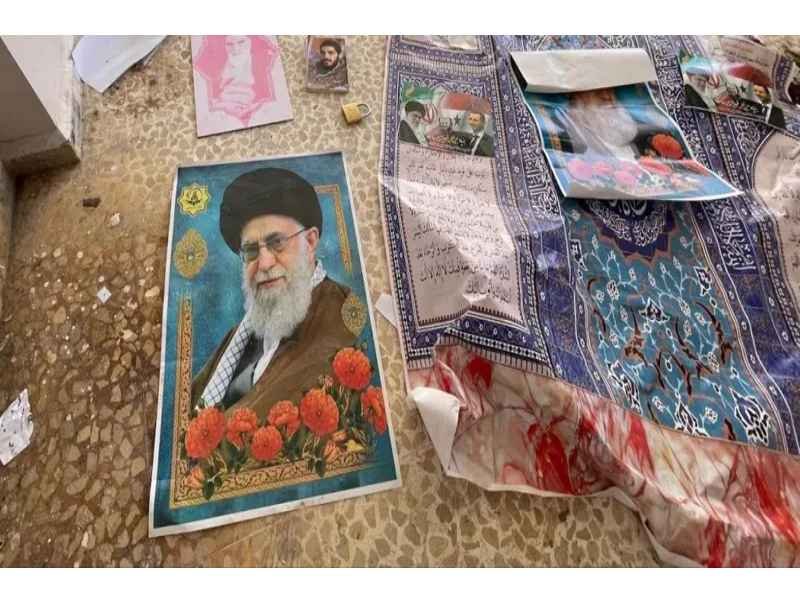- Iran’s forces abruptly abandoned a Syrian base near Khan Shaykhun in December 2024.
- Remnants left behind reveal chaos and panic, signaling a sudden retreat.
- The Iranian military had been entrenched in Syria for over a decade, assisting Assad’s regime.
- A major rift between Assad and Iranian-backed groups marked a dramatic collapse in relations.
- The sudden withdrawal of Iran-linked forces highlights Syria’s shifting alliances.
Iranian-backed forces made a rapid and messy retreat from a key base in Syria’s Idlib province, revealing the crumbling military situation. Once home to Iran’s elite IRGC and allied groups, this base near Khan Shaykhun now stands empty. The remnants of food, military uniforms, and weapons show the chaotic departure after over a decade of presence.
This base, called “The Position of Martyr Zahedi” after an Iranian commander killed in an Israeli airstrike, highlights Iran’s waning influence. Just months ago, the base served as a vital hub for training fighters and supplying arms, especially to Afghan brigades. Now, only the distant sounds of Uyghur militants from Hayaat Tahrir al-Sham fill the air.
The Collapse of Iran’s Strategic Presence in Syria
The sudden withdrawal of Iranian forces has changed the power dynamics dramatically. Militants from HTS, a group linked to Al-Qaeda, took over bases that once housed Iran’s forces. “Iranians were here. They all fled,” says one Uyghur HTS fighter, seen surveying the abandoned base. HTS now fills the power vacuum that Iran left behind.
The relationship between Assad and Iran has also soured. Tensions between Assad and Iranian-backed groups played a key role in Iran’s downfall. Mohammad al Rabbat, an HTS fighter, explains that Iranian forces accused Assad of betraying them. They said he shared their locations with Israel, which caused internal chaos within Iran’s military.
Abdullah, a local resident, remembers the tense moments before Iran’s retreat. “Movement at night was prohibited,” he says. The Iranian presence in his town felt oppressive. Now that the militias are gone, Abdullah’s family feels relief. However, his wife Jourieh still fears being caught in crossfire, recalling how Iranian forces vanished quickly after preparing for a long fight.
The Role of Local Fighters and Changing Alliances
Iran’s sudden retreat has caused a major shift in power dynamics. Militants from HTS, an Al-Qaeda-linked group, have occupied bases once used by Iran’s forces. “Iranians were here. They all fled,” says one Uyghur HTS fighter, seen surveying an abandoned base. HTS now steps in to fill the power vacuum left by Iran.
Tensions between Assad and Iran have worsened over time. The growing rift between Assad and Iranian-backed groups played a key role in Iran’s swift downfall. Mohammad al Rabbat, an HTS fighter, shares that Iranian forces accused Assad of betrayal. They claimed he revealed their locations to Israel, sparking chaos within Iran’s military network.
Abdullah, a local resident, remembers the tense moments before Iran’s retreat. “Movement at night was prohibited,” he says. He felt oppressed by Iran’s presence. Now, with Iranian militias gone, Abdullah’s family feels relief. However, his wife Jourieh still fears the crossfire, recalling how Iranian forces vanished after preparing for a prolonged fight.
Shifting Alliances in Syria: A New Chapter
As Iran’s forces retreat and Assad’s regime crumbles, Syria’s future is uncertain. Interim president Ahmed al-Sharaa has acted swiftly. He banned Iranian nationals from entering the country. Syrians feel growing resentment toward Iranian militias, who took a more active role compared to Russian forces, which mainly focused on airstrikes and military bases.
The relationship between Syria and Iran remains fragile. While Iran’s supreme leader, Ali Khamenei, calls for resistance against foreign forces, Syria’s new leadership treads carefully. Sharaa called the fall of Assad’s regime the “end of the Iranian project,” signaling a policy shift. Still, he hasn’t completely ruled out cooperation with Tehran.
Iran’s rapid retreat from Syria signals a shift in regional power. For years, Iran backed Assad with military presence and political support. Now, Iran’s influence in Syria has hit its lowest point. The swift evacuation of their forces and the rise of new players like HTS show the conflict’s chaotic and unpredictable nature.
Iran’s military dominance has collapsed, leaving Syria in a precarious position. New players like HTS and Russia now step in. The path forward for Syria and its people is unclear. Iran’s withdrawal from bases like the one near Khan Shaykhun will have lasting effects on the region.


